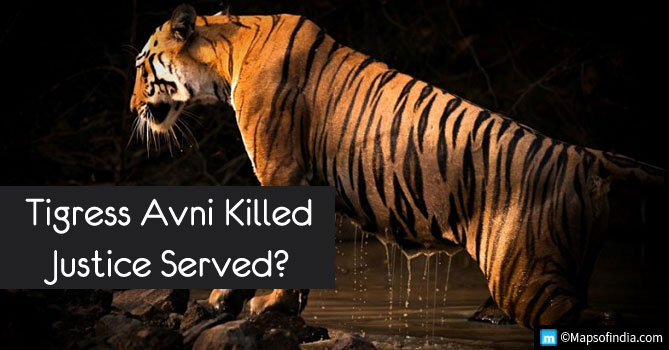
On November 2, after a hunt-down of over two months, tigress Avni was killed in the forests of Maharashtra, India. The 6-year old tigress, officially known as T-1 has left behind two 10-month old cubs. Ever since the hunt began, several people from across the world had stood up to protest against it. While she escaped the Forest Department’s forces, some hope prevailed in the hearts of the activists.
Now, with her death, people mourn yet again. Was the killing justified, and was there really no other solution to the problem?
Who was tigress Avni, why was she shot down?
“Avni was shot dead by sharp-shooter Asgar Ali, son of famous sharp-shooter Nawab Shafat Ali, at compartment no. 149 of Borati forest under the jurisdiction of the Ralegaon police station”, a police official told the media.
The six-year old tigress was first spotted in the year 2012. In August, the tigress along with her cubs, had killed three people in Yavatmal district. Soon after, in September, the Supreme Court indicated that while efforts would be made to capture her alive, but it would not interfere if the rangers were forced to shoot the tigress. Since 2016, the area has 13 recorded deaths by tigers. Out of these, 5 have been linked to Avni based on DNA evidence- with August killings being the final three.
Soon after began a hunt by the Forest Department to track down the tigress. Sniffer dogs, sharp-shooters etc, along with over 200 personnel were deployed for the tracking process. The nearby villages were also under alert, asked to take certain precautions and safety measures. Despite the efforts, the tigress remained untraceable for a long time.
On November 2, the tigress was finally tracked down and killed; her cubs were not present there at the time. “The officers initially tried to nab her alive. However, due to dense forest and darkness, they were unable to do so… a bullet was fired in which the tigress fell on the spot”, said an official.
Petitions and protests
Soon after the judicial system gave out its first order regarding the tigress, a mass of protest began. People from all over the country and even outside, stood together in solidarity, demanding mercy for Avni. “There have been 13 killings, but only three bodies underwent forensic examinations. Of the three, only one had tigress DNA on it”, said Dr. Sarita Subramaniam, co-founder and director of Earth Brigade Foundation.
People showed dissatisfaction for the apex court’s decision to not interfere in the matter, as well as, criticism for the Maharashtra Forest Department. The question often asked is this: When the intention was to tranquilise and capture the animal, not kill it, why was a hunter (Nawab Shaukat Ali Khan) appointed for the job?
Opinion
On October 29th, just a few days prior to Avni’s death, China struck down its 25-year old ban on tiger bones and rhino horns for “medicine and research purposes”. According to activists, this will lead to an increase in demand for wildlife derivatives.
India is home to about 70% of the world’s tiger population, and 85% of single horned rhinos. The decision, then, will automatically pose a threat to the already endangered wildlife in the country. Ironically, it was in the same time frame that Avni was killed. Hers was among the lengthiest operations to hunt down a “man-eater” animal. The question is, should she have been killed?
For one thing, there is no denying that forest area in the country, the natural habitat for wild animals, is quickly depleting. The fast takeover by humans is not a recent trend. This naturally increases the chances and risks of a human-wildlife interaction. According to the protestors, the first dead body was found shortly after 437 hectares worth of mineral-rich land in the forest was illegally sold off to a business.
Secondly, many would argue that it is a problematic approach to refer to Avni as a “man-eating” tigress, since that is not the truth. It is natural for animals like her to attack in self-defense, or even in the cases when their area of living is continuously trespassed in by humans.
Conclusion
Upon hearing the news of Avni’s death, the villagers in the area reportedly celebrated, bursting fire-crackers and distributing sweets. One cannot and should not look past a particular animal’s natural instincts before declare them uncharacteristically dangerous. Moreover, scans show that aside from the two orphaned cubs, the area only has one other tiger- a male adult. Simple common sense would tell you that the tiger population of that particular region will now be in a state of serious threat.
In times when we regularly cite the need for environment and wildlife protection, an incident like this must be looked at more seriously. Was there no way that her death could have been prevented? Had more stricter measures been there to avoid any accidental human interactions with the wildlife animals, lives could have been saved- both of Avni, and of the people killed.




